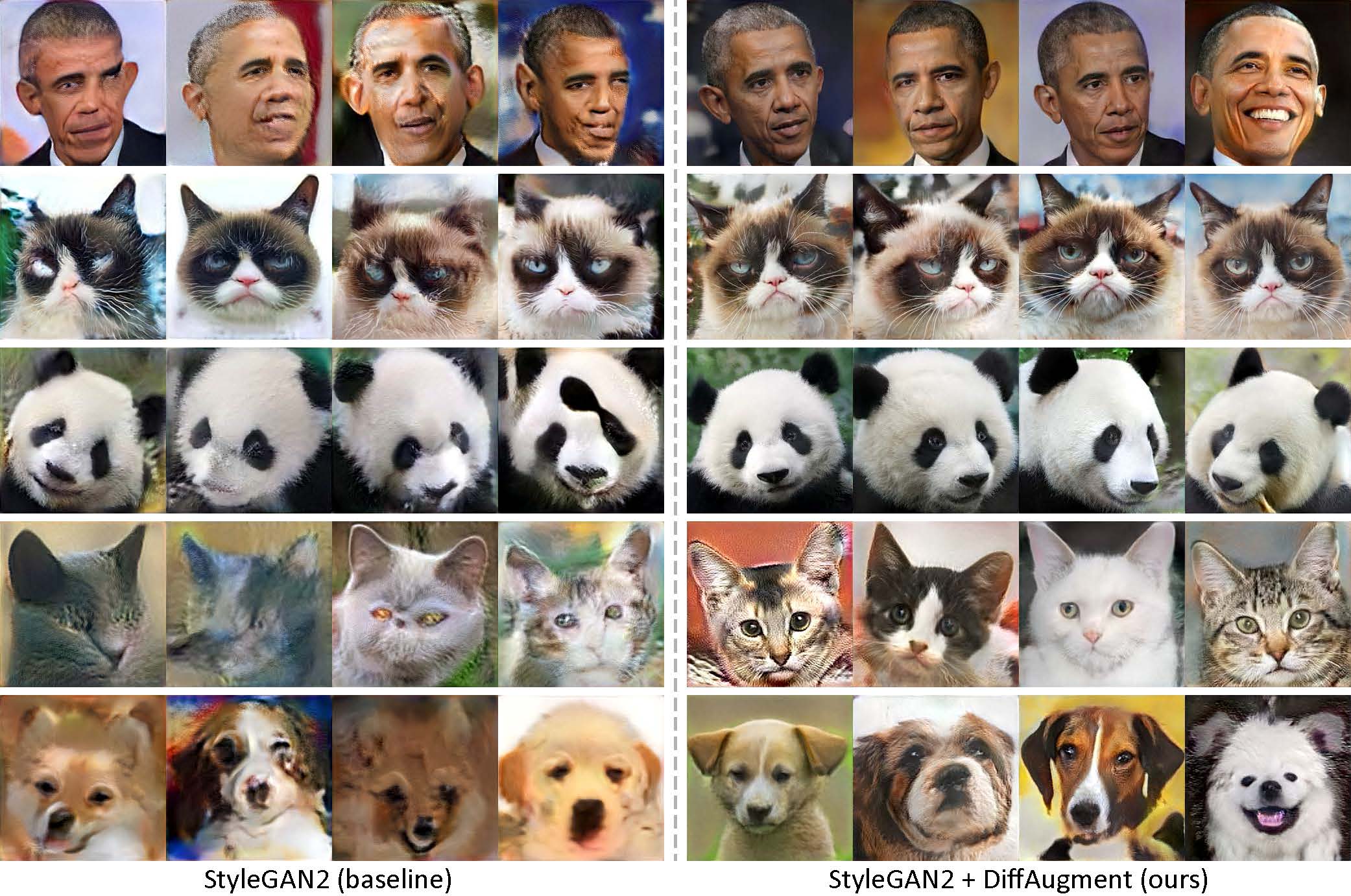Generated using only 100 images of Obama, grumpy cats, pandas, the Bridge of Sighs, the Medici Fountain, the Temple of Heaven, without pre-training.
[NEW!] PyTorch training with DiffAugment-stylegan2-pytorch is now available!
[NEW!] Our Colab tutorial is released!
[NEW!] FFHQ training is supported! See the DiffAugment-stylegan2 README.
[NEW!] Time to generate 100-shot interpolation videos with generate_gif.py!
[NEW!] Our DiffAugment-biggan-imagenet repo (for TPU training) is released!
[NEW!] Our DiffAugment-biggan-cifar PyTorch repo is released!
This repository contains our implementation of Differentiable Augmentation (DiffAugment) in both PyTorch and TensorFlow. It can be used to significantly improve the data efficiency for GAN training. We have provided DiffAugment-stylegan2 (TensorFlow) and DiffAugment-stylegan2-pytorch, DiffAugment-biggan-cifar (PyTorch) for GPU training, and DiffAugment-biggan-imagenet (TensorFlow) for TPU training.
Low-shot generation without pre-training. With DiffAugment, our model can generate high-fidelity images using only 100 Obama portraits, grumpy cats, or pandas from our collected 100-shot datasets, 160 cats or 389 dogs from the AnimalFace dataset at 256×256 resolution.
Unconditional generation results on CIFAR-10. StyleGAN2’s performance drastically degrades given less training data. With DiffAugment, we are able to roughly match its FID and outperform its Inception Score (IS) using only 20% training data.
Differentiable Augmentation for Data-Efficient GAN Training
Shengyu Zhao, Zhijian Liu, Ji Lin, Jun-Yan Zhu, and Song Han
MIT, Tsinghua University, Adobe Research, CMU
arXiv
Overview of DiffAugment for updating D (left) and G (right). DiffAugment applies the augmentation T to both the real sample x and the generated output G(z). When we update G, gradients need to be back-propagated through T (iii), which requires T to be differentiable w.r.t. the input.
To generate an interpolation video using our pre-trained models:
cd DiffAugment-stylegan2
python generate_gif.py -r mit-han-lab:DiffAugment-stylegan2-100-shot-obama.pkl -o obama.gifor to train a new model:
python run_low_shot.py --dataset=100-shot-obama --num-gpus=4You may also try out 100-shot-grumpy_cat, 100-shot-panda, 100-shot-bridge_of_sighs, 100-shot-medici_fountain, 100-shot-temple_of_heaven, 100-shot-wuzhen, or the folder containing your own training images. Please refer to the DiffAugment-stylegan2 README for the dependencies and details.
[NEW!] PyTorch training is now available:
cd DiffAugment-stylegan2-pytorch
python train.py --outdir=training-runs --data=https://data-efficient-gans.mit.edu/datasets/100-shot-obama.zip --gpus=1To run StyleGAN2 + DiffAugment for unconditional generation on the 100-shot datasets, CIFAR, FFHQ, or LSUN, please refer to the DiffAugment-stylegan2 README or DiffAugment-stylegan2-pytorch for the PyTorch version.
Please refer to the DiffAugment-biggan-cifar README to run BigGAN + DiffAugment for conditional generation on CIFAR (using GPUs), and the DiffAugment-biggan-imagenet README to run on ImageNet (using TPUs).
To help you use DiffAugment in your own codebase, we provide portable DiffAugment operations of both TensorFlow and PyTorch versions in DiffAugment_tf.py and DiffAugment_pytorch.py. Generally, DiffAugment can be easily adopted in any model by substituting every D(x) with D(T(x)), where x can be real images or fake images, D is the discriminator, and T is the DiffAugment operation. For example,
from DiffAugment_pytorch import DiffAugment
# from DiffAugment_tf import DiffAugment
policy = 'color,translation,cutout' # If your dataset is as small as ours (e.g.,
# hundreds of images), we recommend using the strongest Color + Translation + Cutout.
# For large datasets, try using a subset of transformations in ['color', 'translation', 'cutout'].
# Welcome to discover more DiffAugment transformations!
...
# Training loop: update D
reals = sample_real_images() # a batch of real images
z = sample_latent_vectors()
fakes = Generator(z) # a batch of fake images
real_scores = Discriminator(DiffAugment(reals, policy=policy))
fake_scores = Discriminator(DiffAugment(fakes, policy=policy))
# Calculating D's loss based on real_scores and fake_scores...
...
...
# Training loop: update G
z = sample_latent_vectors()
fakes = Generator(z) # a batch of fake images
fake_scores = Discriminator(DiffAugment(fakes, policy=policy))
# Calculating G's loss based on fake_scores...
...We have implemented Color, Translation, and Cutout DiffAugment as visualized below:
If you find this code helpful, please cite our paper:
@inproceedings{zhao2020diffaugment,
title={Differentiable Augmentation for Data-Efficient GAN Training},
author={Zhao, Shengyu and Liu, Zhijian and Lin, Ji and Zhu, Jun-Yan and Han, Song},
booktitle={Conference on Neural Information Processing Systems (NeurIPS)},
year={2020}
}
We thank NSF Career Award #1943349, MIT-IBM Watson AI Lab, Google, Adobe, and Sony for supporting this research. Research supported with Cloud TPUs from Google's TensorFlow Research Cloud (TFRC). We thank William S. Peebles and Yijun Li for helpful comments.




